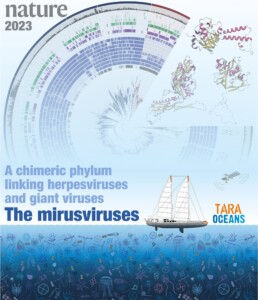Mirusviruses, at the crossroads of evolution
An international team of researchers has discovered “mirusviruses”, a new group of DNA viruses, among the massive sequencing data generated at Genoscope from samples collected during Tara Oceans expeditions, and partly funded by France Génomique. These viruses, which are abundant on the surface of the oceans and seas where they infect part of the plankton, have a very complex genome with multiple origins. The majority of their genes, including those needed for DNA duplication and transcription, are similar to those of giant viruses. But the genes involved in the formation of the viral capsule, which define the taxonomic identity of viruses, reveal an evolutionary link with the herpes virus family, a well-known pathogen of humans. These results, published in Nature, intrigue, these two families of viruses belonging to two very different groups from the point of view of evolution. The unique evolutionary mix of mirusviruses raises questions: did giant viruses integrate mirusvirus genes or vice versa? Could there be a common ancestor to giant viruses and Herpes viruses? The discovery of mirusviruses offers many opportunities to study the ecology and elucidate the evolutionary trajectory of DNA viruses, in the oceans and beyond. The mirusviruses have not finished talking about them.


